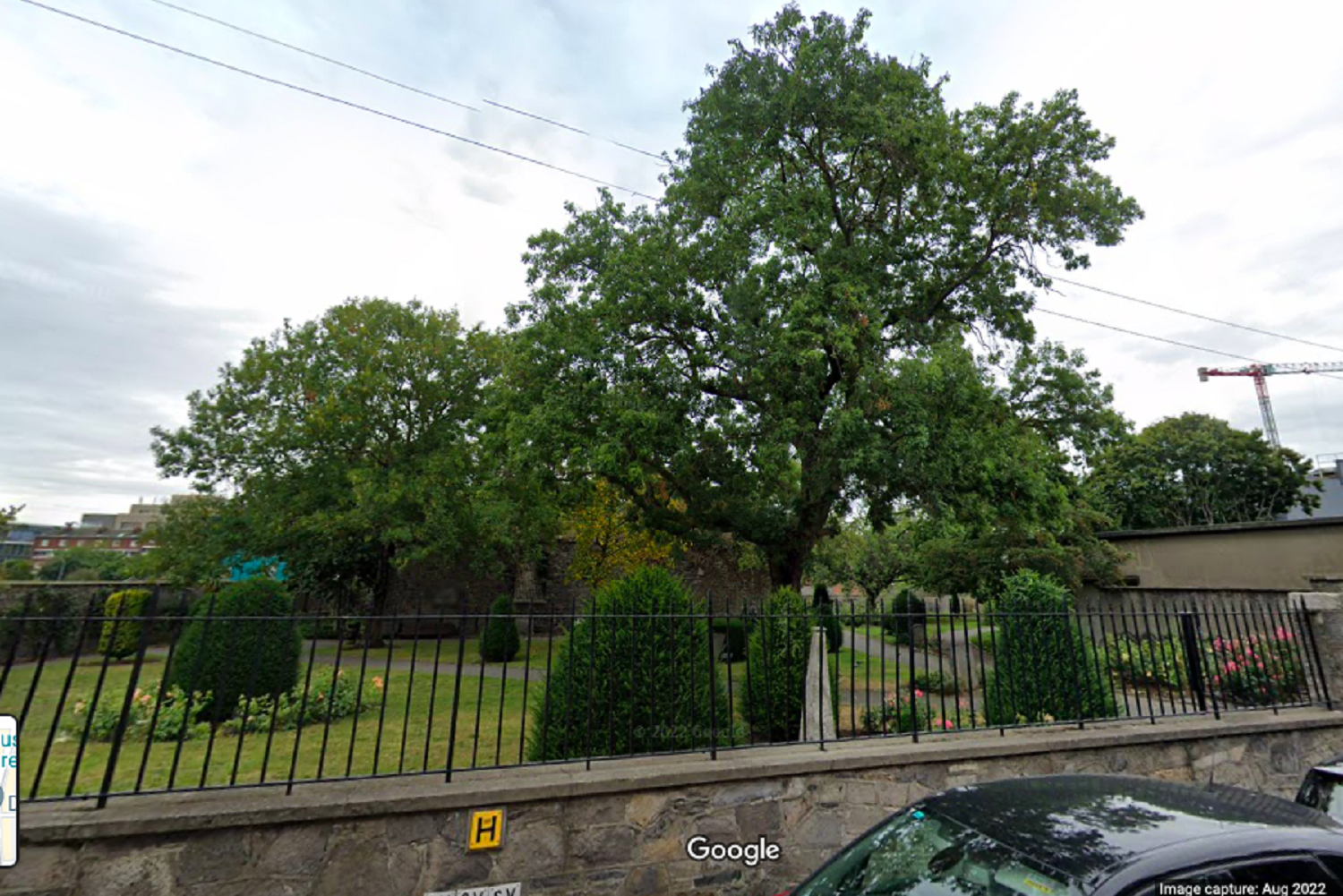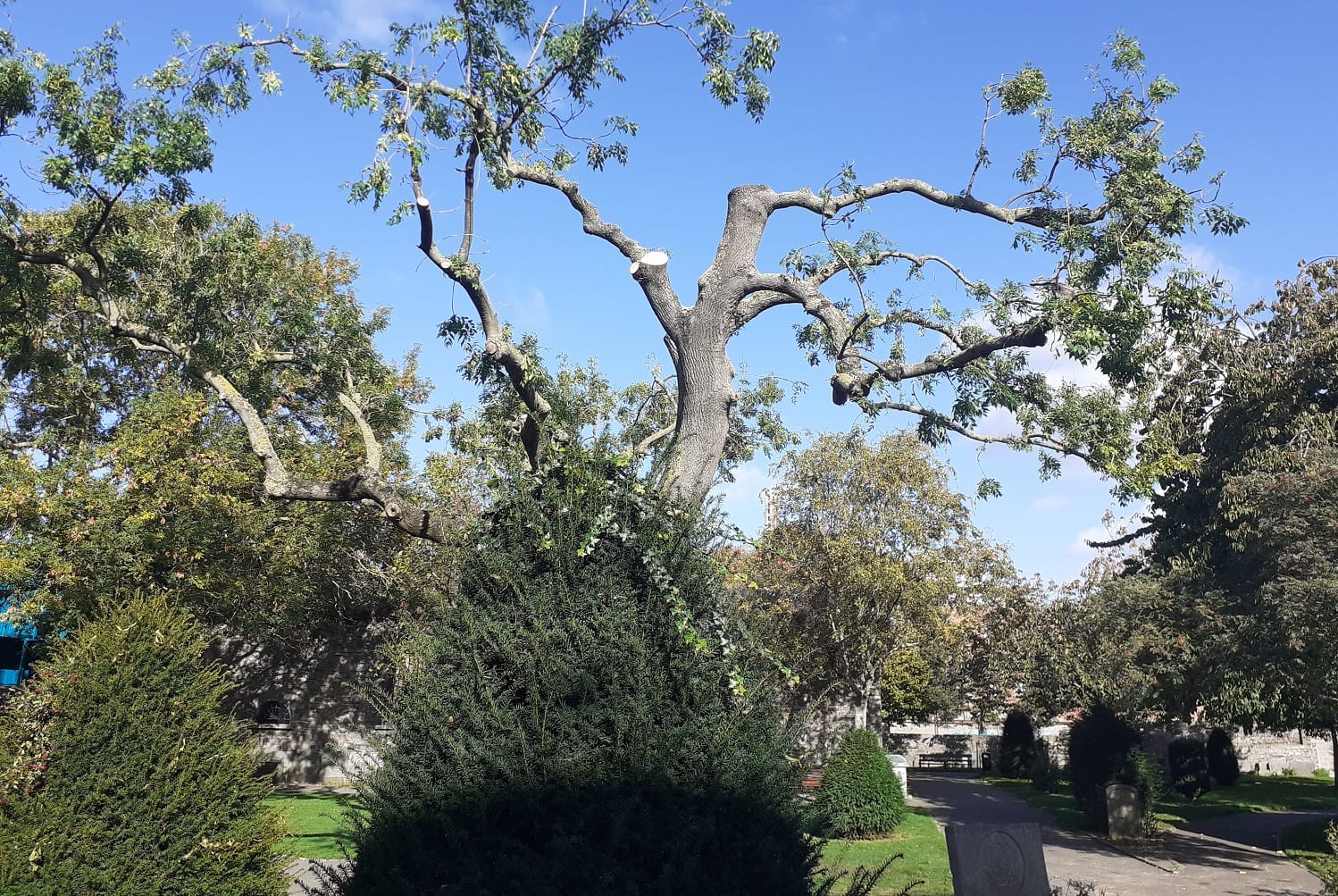What’s the best way to tell area residents about plans for a new asylum shelter nearby?
The government should tell communities directly about plans for new asylum shelters, some activists and politicians say.
Two ash trees there are in natural decline, the council says, so they chopped some branches to keep them as healthy as possible, and visitors safe – but did they cut too much?

The tree looked so much bigger a week earlier, says John Burke. He leans forward on the bench, turning his eyes upward, holding his arms out wide.
“I looked up – oh, my god, they’ve cut the branches off it,” he says.
That revelation had come during his visit to St Kevin’s Park in Portobello on Sunday, after he had settled into the bench to the west of the green where the tree stands. “From over there, I could see the expansion of the tree,” he says.
St Kevin’s Park, a tidy green enclosed by a stone wall and iron grate, is tucked off Camden Row in the south inner-city.
The ruins of St Kevin’s Church stand in the middle, with trees, rose bushes and benches dotted around where people can spend time having lunch, or getting some fresh air.
Freshly carved stumps now lie at the ends of the branches of the ash tree at the entrance to the park.
“It’s a great pity,” Burke says, from his secluded spot behind the church ruins, from where the bough of the tree can be seen. “What draws your attention is the big tree. And that was always a big feeling as well. I love that tree.”
“I often said to a friend of mine, ‘You should go into St Kevin’s Park and look at this tree,’” he says. “It looks so old.”
A Dublin City Council spokesperson on Monday said that the tree is in natural decline and had a fungal infection, so some branches were chopped to make sure they didn’t fall on anyone.
A smaller ash tree in the park was “crown-reduced” (pruned), to remove brittle branches for public safety and to protect the church ruins, said the spokesperson. “Both trees will require pruning every 3 to 5 years.”
Michael Gary, an arboriculturist, or tree consultant for Arbor Care, which does tree inspections, says that sometimes, for health and safety reasons or for the health of the tree, it’s necessary to prune.
But tree surgeons might be inclined to take too much of the tree away, which can be damaging, Gary says. An arborist should inspect the tree first, to see what the least amount they can prune is.
The council didn’t respond to a query sent Tuesday asking if an arborist had inspected the ash trees in St Kevin’s Park before they were pruned.
Sean Delaney, standing near the entrance of the park on Tuesday, holding a coffee cup, turns and looks up at the bare branches of the ash tree, which he notices sometimes when visiting St Kevin’s Park. “It’s obviously quite old. It’s very beautiful, like.”
He hadn’t noticed the council had pruned it, until now. “If it saves the tree, it’s probably beneficial for it,” he says.
In one of the main limbs of the large ash tree, fungal decay had been observed, said the council spokesperson. “This decay will make the tree limbs brittle, leading to fractures and posing a potential risk to the public if not pruned.”

Gary, the arborist, says trees should only be pruned for two reasons: to benefit the tree, or to prevent a health and safety hazard.
Crown-reducing a tree removes dead, dying or diseased branches within the tree’s canopy and can improve the airflow in the tree, he says. “Some trees might be unbalanced, or top-heavy, and might require a light prune just to balance them.”
Thomas Carton, next to Delaney, says the pruning looks awful. “They did pretty much butcher the thing to be honest. It does kind of take away the look of it, overall.”
It’s a pity when pruning has to be done, whether for health and safety or disease, Carton says. “Ideally, I’d like if it wasn’t done. I like the look of trees, I think you should leave them.”
Burke, leaning over to peer around the church ruins for a better look, says the tree looks dreadful.
“It looks like, sort of, the teeth came in during the night, or some people came in during the night, and said, ‘We’re going to do something,’” he says. “‘We’re going to do damage to that tree’, and they have a saw, and they just sawed it off, and sawed it off, and sawed it off.”
It’s important that an arborist or tree consultant does an inspection of the tree, says Gary, because tree surgeons often remove more of the tree than necessary.
A tree surgeon is generally the person who will do the physical tree pruning, he says, whereas an arborist will carry out health and safety inspections of trees, and do up a report to be passed on to a tree surgeon. “And he or she should only work off that spec.”
“A lot of times tree surgeons are recommending pruning works without understanding what impacts they’re going to have on the trees,” he says.
They might recommend pruning 30–40 percent of the tree. “Which effectively will really stress the tree, or kill the tree.”
Removing too much of the tree could unbalance the tree even more. “It could open the tree up to infection and diseases.”
The council didn’t respond to queries sent Tuesday asking what percentage of the tree was cut, and whether they consulted an arborist.

Not all tree surgeons have tree-cultivation qualifications, just skills in pruning or removing trees, says Gary, the arboriculturist. “But no qualifications in the study of trees, the theology of trees. What they’re pruning, what impact that’s going to have on the health and condition of the tree.”
Tree surgeons make money from cutting the tree, he says. “I make my money by inspecting trees, so I would inspect the tree impartially.”
Trees in public should be inspected every year by a qualified arborist, he says, so that diseases can be managed, and too much of the tree isn’t pruned.
“Scheduled inspections, and that will reduce the risk of something happening,” he says, and diseases can be caught quickly and treated without too much pruning.
The council didn’t respond to queries asking how often the trees in St Kevin’s Park are inspected.
Sometimes, after complaints from residents about trees, councils might remove them because it’s cheaper than getting an inspection done and getting appropriate treatment, he says.
“A lot of times trees are pruned just for facetious reasons,” he says. Like blocking light, too many leaves to rake up, blocking satellite dishes, or being perceived as dangerous. “Whereas many times the real reason is because people simply don’t like trees.”
Burke, resting a hand on his walker and sitting up on the bench, says other trees in the park aren’t as impressive as the big ash tree.
He turns slowly to his left, to some springy birch trees shooting up from the grass, each supported by a piece of wood attached to them. “They’re nothing to look at. They’re being supported, and okay they’re straight.”
Burke turns back, a smile in his eyes, to gesture at the big tree. “It’s standing on its own, there’s nothing to support it, and it’s been there for years and years and years and years.”
Other trees, he’ll notice them getting their leaves and losing them again each year. But he doesn’t see them like the big tree. “They haven’t got an impact into me, into my brain, as the big tree was – or is.”
Delaney, near the gate with his coffee cup, thinks the council should have put up a sign about the pruning of the tree, giving some information. “Something to say as well, that we have had to cut it.”
Burke says so too. “I think they could put a notice on the door or something like that, we are going to have to cut the branches,” he says. “From an environmental point of view, it would be educating people who know nothing.”
“It’s a great pity. But I didn’t know the reason. And now I know the reason,” he says. “But see, you’ve no one to ask.”
Get our latest headlines in one of them, and recommendations for things to do in Dublin in the other.